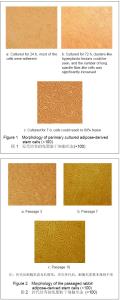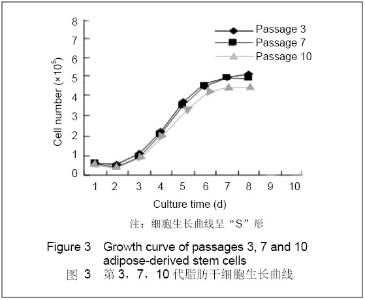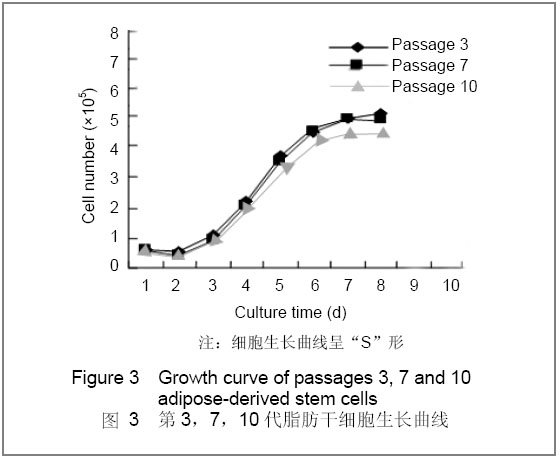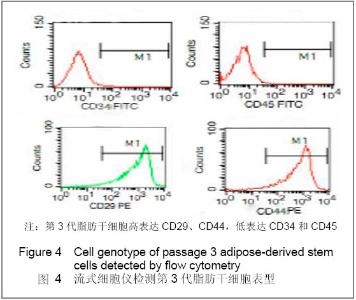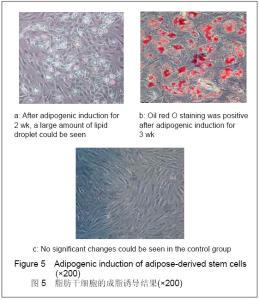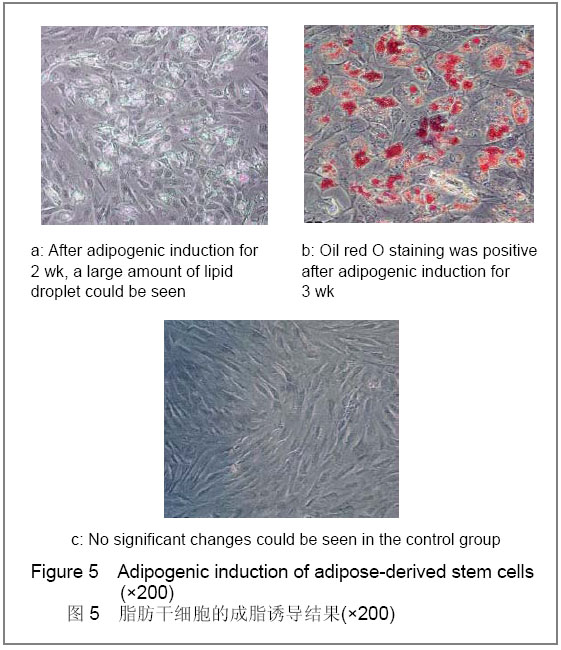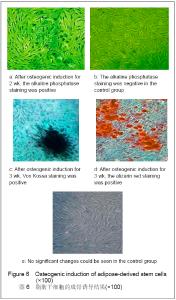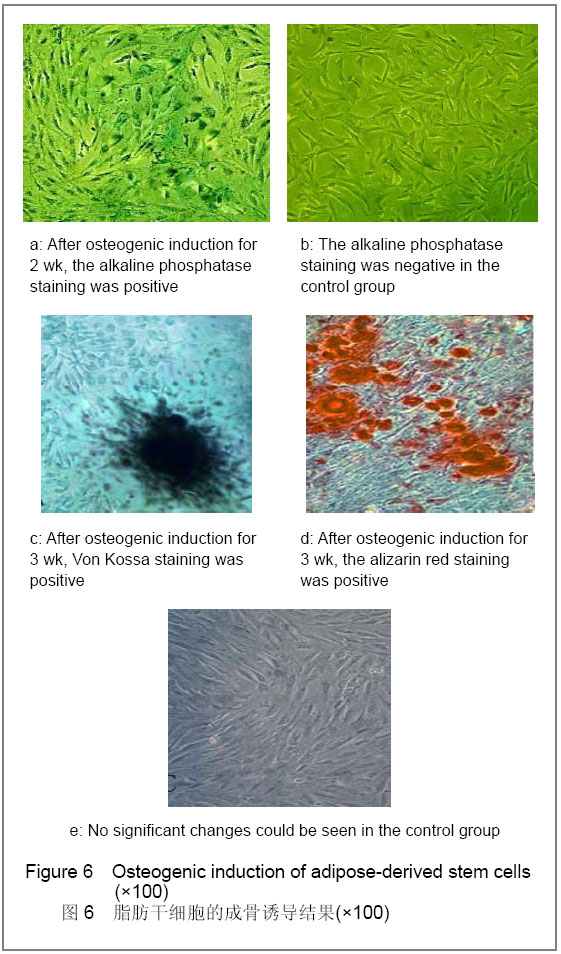Chinese Journal of Tissue Engineering Research ›› 2012, Vol. 16 ›› Issue (49): 9162-9167.doi: 10.3969/j.issn.2095-4344.2012.49.008
Previous Articles Next Articles
Multi-directional induced differentiation of rabbit adipose-derived stem cells
Wang Qing-fu , Chen Zhuang-hong, Cai Xian-hua, Xie Yong-hui, Diao Bo, Liu Qin
- Department of Orthopedics, Wuhan General Hospital of Guangzhou Military Command, Wuhan 430070, Hubei Province, China
-
Received:2012-06-01Revised:2012-10-25Online:2012-12-02Published:2013-01-16 -
Contact:Chen Zhuang-hong, Professor, Chief physician, Doctoral supervisor Department of Orthopedics, Wuhan General Hospital of Guangzhou Military Command, Wuhan 430070, Hubei Province, China -
About author:Wang Qing-fu☆, Studying for doctorate, Department of Orthopedics, Wuhan General Hospital of Guangzhou Military Command, Wuhan 430070, Hubei Province, China -
Supported by:Supported by: “Eleventh Five-Year” Project of PLA , No. 06G047*
CLC Number:
Cite this article
Wang Qing-fu,Chen Zhuang-hong, Cai Xian-hua, Xie Yong-hui, Diao Bo, Liu Qin. Multi-directional induced differentiation of rabbit adipose-derived stem cells[J]. Chinese Journal of Tissue Engineering Research, 2012, 16(49): 9162-9167.
share this article
| [1] Zuk PA, Zhu M, Mizuno H, et al.Multilineage cellsfrom human adipose tissue:implications for cell based therapies.Tissue Eng,2001,7(2):211-228.[2] National Academy of Sciences,Institute of Laboratory Animal Resources,Commission on Life Sciences,National Research Council.Guide for the care and use of laboratory animals.[3] Zuk PA,Zhu M, Ashjian P, et al. Human adipose tissue is a source ofmultipotent stem cells. MolBiol Cell.2002;13(12): 4279-4295.[4] Williams KJ, Picou AA, Kish SL, et al. Isolation and characterization of porcine adipose tissue-derived adult stem cells. Cells Tissues Organs.2008;188(3): 251-258. [5] Miyazaki M, Zuk PA, Zou J, et al. Comparison of human mesenchymal stem cells derived from adipose tissue and bone marrow for ex vivo gene therapy in rat spinal fusion model. Spine. 2008;33(8): 863-869. [6] CherubinoM,Marra KG. Adipose-derived stem cells for soft tissue reconstruction. Regen Med.2009;4(1):109-117. [7] Anghileri E, Marconi S, Pignatelli A, et al. Neuronal differentiation potential of human adipose-derived mesenchymal stem cells. Stem Cells Dev. 2008;17(5): 909-916. [8] Zaminy A, RagerdiKashani I, Barbarestani M, et al. Osteogenic differentiation of rat mesenchymal stem cells from adipose tissue in comparison with bone marrow mesenchymal stem cells: melatonin as a differentiation factor. Iran Biomed J.2008;12(3): 133-141. [9] Gimble JM, Guilak F. Adipose-derived adult stemcells: isolation,characterization,anddifferentiation potential. Cytotherapy.2003,5(5):362-369.[10] Kim DH, Je CM, Sin JY, et al. Effect of partial hepatectomy on in vivo engraftment after intravenous administration of human adipose tissue stromal cells in mouse. Microsurgery.2003; 23(5):424-431.[11] Rangappa S, Fen C, Lee EH, et al. Transformation of adult mesenchymal stem cells isolated from the fatty tissue into cardiomyocytes. Ann Thorac Surg.2003;75(3):775-779.[12] Wang Y, Chen GH, Shao JH, et al. Shandong DaxueXuebao. 2005;43(7):578-581.[13] Sgodda M, Aurich H, Kleist S, et al. Hepatocyte differentiation of mesenchymal stem cells from rat peritoneal adipose tissue in vitro and in vivo. Exp Cell Res.2007;313(13):2875-2886. [14] Afizah H, Yang Z, Hui JH, et al. A comparison between the chondrogenic potential of human bone marrow stem cells (BMSCs) and adipose-derived stem cells (ADSCs) taken from the same donors. Tissue Eng.2007;13(4):659-666.[15] Cam pagnoli C, Roberts IA, Kumar S, et al. Identification ofmesenchymal stem/progenitor cells in human firsttrim ester fetal blood, liver and bone marrow.B lood, 2001,98(8):2396- 2402.[16] Safford KM, Hicok KC, Safford SD, et al. Neurogenic differentiation of murineand human adipose-derived stromal cells.BiochemBiophys Res Commun.2002;294(2):371-379[17] Gronthos S,Franklin DM, Leddy HA, et al. Surfaceproteincharacterization of human adipose tissue-derived stromal cells. Cell Physiol.2001;189(1):54-63.[18] Boquest AC, Shahdadfar A, Frønsdal K, et al.Isolation and transcription profiling of purified uncultured human stromal stem cells: alteration of gene expressionafter in vitrocellculture. MolBiolCell.2005;16(3):1131-1141. |
| [1] | Lyu Ruyue, Gu Lulu, Liu Qian, Zhou Siyi, Li Beibei, Xue Letian, Sun Peng. Regulatory mechanisms of exosome secretion and its application prospects in biomedicine [J]. Chinese Journal of Tissue Engineering Research, 2026, 30(1): 184-193. |
| [2] | Xu Canli, He Wenxing, Wang Yuping, Ba Yinying, Chi Li, Wang Wenjuan, Wang Jiajia. Research context and trend of TBK1 in autoimmunity, signaling pathways, gene expression, tumor prevention and treatment [J]. Chinese Journal of Tissue Engineering Research, 2026, 30(在线): 1-11. |
| [3] | Liu Xun, Ouyang Hougan, Pan Rongbin, Wang Zi, Yang Fen, Tian Jiaxuan . Optimal parameters for physical interventions in bone marrow mesenchymal stem cell differentiation [J]. Chinese Journal of Tissue Engineering Research, 2025, 29(31): 6727-6732. |
| [4] | Hu Enxi, He Wenying, Tao Xiang, Du Peijing, Wang Libin. Regulation of THZ1, an inhibitor of cyclin-dependent kinase 7, on stemness of glioma stem cells and its mechanism [J]. Chinese Journal of Tissue Engineering Research, 2025, 29(25): 5374-5381. |
| [5] | Lin Meiyu, Zhao Xilong, Gao Jing, Zhao Jing, Ruan Guangping. Action mechanism and progress of stem cells against ovarian granulosa cell senescence [J]. Chinese Journal of Tissue Engineering Research, 2025, 29(25): 5414-5421. |
| [6] | Tian Zhenli, Zhang Xiaoxu, Fang Xingyan, Xie Tingting. Effects of sodium arsenite on lipid metabolism in human hepatocytes and regulatory factors [J]. Chinese Journal of Tissue Engineering Research, 2025, 29(23): 4956-4964. |
| [7] | Han Fang, Shu Qing, Jia Shaohui, Tian Jun. Electrotactic migration and mechanisms of stem cells [J]. Chinese Journal of Tissue Engineering Research, 2025, 29(23): 4984-4992. |
| [8] | Hu Chen, Jiang Ying, Chen Jia, Qiao Guangwei, Dong Wen, Ma Jian. Preparation and characterization of alendronate/chitosan/polyvinyl alcohol composite hydrogel films [J]. Chinese Journal of Tissue Engineering Research, 2025, 29(22): 4720-4730. |
| [9] | Yang Chao, Luo Zongping. Small molecule drug TD-198946 enhances osteogenic differentiation of rat bone marrow mesenchymal stem cells [J]. Chinese Journal of Tissue Engineering Research, 2025, 29(13): 2648-2654. |
| [10] | Li Xiaofeng, Zhao Duo, Ouyang Qin, Pang Zixiang, Li Yuquan, Chen Qianfen. Protective effect of mangiferin on oxidative stress injury in rat bone marrow mesenchymal stem cells [J]. Chinese Journal of Tissue Engineering Research, 2025, 29(13): 2669-2674. |
| [11] | Hu Zezun, Yang Fanlei, Xu Hao, Luo Zongping. Effect of surface roughness of polydimethylsiloxane on osteogenic differentiation of bone marrow mesenchymal stem cells under stretching conditions [J]. Chinese Journal of Tissue Engineering Research, 2025, 29(10): 1981-1989. |
| [12] | Yang Zhihang, Sun Zuyan, Huang Wenliang, Wan Yu, Chen Shida, Deng Jiang. Nerve growth factor promotes chondrogenic differentiation and inhibits hypertrophic differentiation of rabbit bone marrow mesenchymal stem cells [J]. Chinese Journal of Tissue Engineering Research, 2025, 29(7): 1336-1342. |
| [13] | Huang Ting, Zheng Xiaohan, Zhong Yuanji, Wei Yanzhao, Wei Xufang, Cao Xudong, Feng Xiaoli, Zhao Zhenqiang. Effects of macrophage migration inhibitory factor on survival, proliferation, and differentiation of human embryonic stem cells [J]. Chinese Journal of Tissue Engineering Research, 2025, 29(7): 1380-1387. |
| [14] | Liu Haowen, Qiao Weiping, Meng Zhicheng, Li Kaijie, Han Xuan, Shi Pengbo. Regulation of osteogenic effects by bone morphogenetic protein/Wnt signaling pathway: revealing molecular mechanisms of bone formation and remodeling [J]. Chinese Journal of Tissue Engineering Research, 2025, 29(3): 563-571. |
| [15] | Zhou Shijie, Li Muzhe, Yun Li, Zhang Tianchi, Niu Yuanyuan, Zhu Yihua, Zhou Qinfeng, Guo Yang, Ma Yong, Wang Lining. Effect of Wenshen Tongluo Zhitong formula on mouse H-type bone microvascular endothelial cell/bone marrow mesenchymal stem cell co-culture system [J]. Chinese Journal of Tissue Engineering Research, 2025, 29(1): 8-15. |
| Viewed | ||||||
|
Full text |
|
|||||
|
Abstract |
|
|||||
